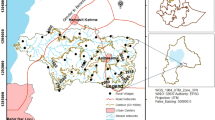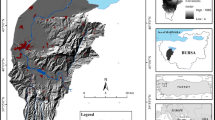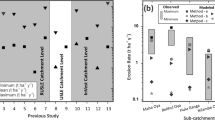Abstract
Since the past two decades, watershed management practices such as construction of stone bunds and establishment of exclosures have been widely implemented in the semi-arid highlands of northern Ethiopia to curb land degradation by soil erosion. This study assessed changes in soil erosion for the years 1990, 2000 and 2012 as a result of such watershed management practices in Agula watershed using the Revised Universal Soil Loss Equation. The Revised Universal Soil Loss Equation factors were computed in a geographic information system for 30 × 30 m raster layers using spatial data obtained from different sources. The results revealed significant reduction in soil loss rates by about 55 % from about 28 to 12 t ha−1 per year in 1990–2000 and an overall 64 % reduction from 28 to 10 t ha−1 per year in 1990–2012. This change in soil loss is attributed to improvement in surface cover and stone bund practices, which resulted in the decrease in mean C and P-factors, respectively, by about 19 % and 34 % in 1990–2000 and an overall decrease in C-factor by 29 % in 1990–2012. Considerable reductions in soil loss were observed from bare land (89 %), followed by cultivated land (56 %) and shrub land (49 %). Furthermore, the reduction in soil loss was more pronounced in steeper slopes where very steep slope and steep slope classes experienced over 70 % reduction. Validation of soil erosion estimations using field observed points showed an overall accuracy of 69 %, which is fairly satisfactory. This study demonstrated the potential of watershed management efforts to bring remarkable restoration of degraded semi-arid lands that could serve as a basis for sustainable planning of future developments of areas experiencing severe land degradation due to water erosion.








Similar content being viewed by others
References
Adimassu Z, Mekonnen K, Yirga C, Kessler A (2014) Effect of soil bunds on runoff, soil and nutrient losses, and crop yield in the central highlands of Ethiopia. Land Degrad Dev 25(6):554–564
Aerts R, Nyssen J, Haile M (2009) On the difference between “exclosures” and “enclosures” in ecology and the environment. J Arid Environ 73(8):762–763
Alemayehu F, Taha N, Nyssen J, Girma A, Zenebe A et al. (2009) The impacts of watershed management on land use and land cover dynamics in Eastern Tigray (Ethiopia). Resour Conserv Recy 53(4):192–198
Amsalu A, Stroosnijder L, de Graaff J (2007) Long-term dynamics in land resource use and the driving forces in the Beressa watershed, highlands of Ethiopia. J Environ Manage 83(4):448–459
Ananda J, Herath G (2003) Soil erosion in developing countries: a socio-economic appraisal. J Environ Manage 68(4):343–353
Berry L (2003) Land degradation in Ethiopia: its extent and impact. The World Bank, Washington DC
Bewket W, Teferi E (2009) Assessment of soil erosion hazard and prioritization for treatment at the watershed level: case study in the Chemoga watershed, Blue Nile basin, Ethiopia. Land Degrad Dev 20(6):609–622
Chatterjee S, Krishna AP, Sharma AP (2014) Geospatial assessment of soil erosion vulnerability at watershed level in some sections of the Upper Subarnarekha river basin, Jharkhand, India. Environ Earth Sci 71(1):357–374
Cohen MJ, Shepherd KD, Walsh MG (2005) Empirical reformulation of the universal soil loss equation for erosion risk assessment in a tropical watershed. Geoderma 124(3):235–252
Congalton RG (1991) A review of assessing the accuracy of classifications of remotely sensed data. Remote Sens Environ 37(1):35–46
Descheemaeker K, Nyssen J, Poesen J, Raes D, Haile M et al. (2006) Runoff on slopes with restoring vegetation: a case study from the Tigray highlands, Ethiopia. J Hydrol 331(1):219–241
de Vente J, Poesen J, Verstraeten G, Van Rompaey A, Govers G (2008) Spatially distributed modelling of soil erosion and sediment yield at regional scales in Spain. Glob Planet Change 60(3):393–415
El-Swaify SA, Hurni H (1996) Transboundary effects of soil erosion and conservation in the Nile basin. Land Husbandry 1(1/2):5–21
Erdogan EH, Erpul G, Bayramin İ (2007) Use of USLE/GIS methodology for predicting soil loss in a semiarid agricultural watershed. Environ Monit Assess 131(1-3):153–161
Esser K, Vågen TG, Tilahun Y, Haile M (2002) Soil conservation in Tigray, Ethiopia. Noragric Report No. 5. Agricultural University of Norway
Farhan Y, Zregat D, Farhan I (2013) Spatial estimation of soil erosion risk using RUSLE approach, RS, and GIS techniques: a case study of Kufranja watershed, Northern Jordan. J Water Resource Prot 5(12):1247–1261
Fenta AA, Yasuda H, Shimizu K, Haregeweyn N (2016) Response of streamflow to climate variability and changes in human activities in the semiarid highlands of northern Ethiopia. Reg Environ Change (submitted).
Gebremedhin B, Swinton SM (2003) Investment in soil conservation in northern Ethiopia: the role of land tenure security and public programs. Agric Econ 29(1):69–84
Gebremichael D, Nyssen J, Poesen J, Deckers J, Haile M et al. (2005) Effectiveness of stone bunds in controlling soil erosion on cropland in the Tigray Highlands, northern Ethiopia. Soil Use Manage 21(3):287–297
Getachew B (2007) Birki integrated watershed management study report. Tigray Bureau of Water Resources, Mekelle, Ethiopia
Girmay G, Singh BR, Nyssen J, Borrosen T (2009) Runoff and sediment-associated nutrient losses under different land uses in Tigray, Northern Ethiopia. J Hydrol 376(1):70–80
Haregeweyn N, Berhe A, Tsunekawa A, Tsubo M, Meshesha DT (2012) Integrated watershed management as an effective approach to curb land degradation: a case study of the Enabered watershed in northern Ethiopia. Environ Manage 50(6):1219–1233
Haregeweyn N, Poesen J, Deckers J, Nyssen J, Haile M, Govers G (2008) Assessment and evaluation of sediment-bound nutrient export and associated costs from micro-dam catchments of Northern Ethiopia. Land Degrad Dev 19:136–152
Haregeweyn N, Poesen J, Nyssen J, De Wit J, Haile H, Govers G (2006) Reservoirs in Tigray: characteristics and sediment deposition problems. Lan2d Degrad Dev 17(2):211–230
Haregeweyn N, Poesen J, Verstraeten G, Govers G, Vente J et al. (2013) Assessing the performance of a spatially distributed soil erosion and sediment delivery model (WATEM/SEDEM) in Northern Ethiopia. Land Degrad Dev 24(2):188–204
Haregeweyn N, Tsunekawa A, Nyssen J, Poesen J, Tsubo M et al. (2015) Soil erosion and conservation in Ethiopia: a review. Prog Phys Geogr 39(6):750–774
Helldén U (1987) An assessment of woody biomass, community forests, land use and soil erosion in Ethiopia. Lund University Press, Lund
Herweg K, Ludi E (1999) The performance of selected soil and water conservation measures-case studies from Ethiopia and Eritrea. Catena 36(1):99–114
Hrissanthou V, Delimani P, Xeidakis G (2010) Estimate of sediment inflow into Vistonis Lake, Greece. Int J Sediment Res 25:161–174
Hunting Technical Service (HTS) (1976) Tigray Rural Development Study. HTS, Hemel Hempstead
Hurni H (1985) Soil Conservation Manual for Ethiopia: a field manual for conservation implementation. Soil Conservation Research Project, Ministry of Agriculture, Addis Ababa
Hurni H (1988) Degradation and conservation of the resources in the Ethiopian highlands. Mt Res Dev 8:123–130
Hurni H (1993). Land degradation, famine, and land resource scenarios in Ethiopia. In: Pimentel D. (ed) World soil erosion and conservation. Cambridge University Press, Cambridge, pp 27–62
Hurni K, Zeleke G, Kassie M, Tegegne B, Kassawmar T et al. (2015) Soil degradation and sustainable land management in the rainfed agricultural areas of Ethiopia: an assessment of the economic implications. Report for the Economics of Land Degradation Initiative
Igbokwe KN, Adede J (2001) Integrated watershed management in Eastern Tigray, Ethiopia. Midterm impact evaluation report, Nairobi
Jain MK, Kothyari UC (2000) Estimation of soil erosion and sediment yield using GIS. Hydrol Sci J 45(5):771–786
Jetten V, Govers G, Hessel R (2003) Erosion models: quality of spatial predictions. Hydrol Process 17(5):887–900
Jiang Z, Su S, Jing C, Lin S, Fei X, Wu J (2012) Spatiotemporal dynamics of soil erosion risk for Anji County, China. Stoch Environ Res Risk Assess 26(6):751–763
Lanckriet S, Derudder B, Naudts J, Bauer H, Deckers J et al. (2015) A political ecology perspective of land degradation in the north Ethiopian highlands. Land Degrad Develop 26:521–530
Lu D, Li G, Valladares GS, Batistella M (2004) Mapping soil erosion risk in Rondonia, Brazilian Amazonia: using RUSLE, remote sensing and GIS. Land Degrad Dev 15(5):499–512
Mekuria W, Veldkamp E (2012) Restoration of native vegetation following exclosure establishment on communal grazing lands in Tigray, Ethiopia. Appl Veg Sci 15(1):71–83
Mekuria W, Veldkamp E, Haile M, Gebrehiwot K, Muys B, Nyssen J (2009) Effectiveness of exclosures to control soil erosion and local community perception on soil erosion in Tigray, Ethiopia. Afr J Agric Res 4:365–377
Meshesha DT, Tsunekawa A, Tsubo M, Haregeweyn N (2012) Dynamics and hotspots of soil erosion and management scenarios of the central Rift Valley of Ethiopia. Int J Sediment Res 27(1):84–99
Ministry of Water, Irrigation and Electricity of Ethiopia (MoWIE) (1997) Tekeze river basin integrated development master plan. Addis Ababa
Moore ID, Wilson JP (1992) Length-slope factors for the revised universal soil loss equation. Simplified method of estimation. Soil Water Conserv 47:42–428
Morgan RPC, Quinton JN, Smith RE, Govers G, Poesen J et al. (1998) The European Soil Erosion Model (EUROSEM): a dynamic approach for predicting sediment transport from fields and small catchments. Earth Surf Process Landf 23(6):527–544
Nearing MA, Foster GR, Lane LJ, Finkner SC (1989) A process based soil erosion model for USDA-water erosion prediction project technology. Trans ASAE 32:1587–1593
Nyssen J, Clymans W, Poesen J, Vandecasteele I, De Baets S et al. (2009a) How soil conservation affects the catchment sediment budget–a comprehensive study in the north Ethiopian highlands. Earth Surf Process Landf 34(9):1216–1233
Nyssen J, Poesen J, Descheemaeker K, Haregeweyn N, Haile M et al. (2008) Effects of region-wide soil and water conservation in semi-arid areas: the case of northern Ethiopia. Z Geomorph 52(3):291–315
Nyssen J, Poesen J, Gebremichael D, Vancampenhout K, D’aes M et al. (2007) Interdisciplinary on-site evaluation of stone bunds to control soil erosion on cropland in northern Ethiopia. Soil Tillage Res 94(1):151–163
Nyssen J, Poesen J, Haile M, Moeyersons J, Deckers J, Hurni H (2009b) Effects of land use and land cover on sheet and rill erosion rates in the Tigray highlands, Ethiopia. Z Geomorph 53(2):171–197
Nyssen J, Poesen J, Veyret-Picot M, Moeyersons J, Haile M, Deckers J (2006) Assessment of gully erosion rates through interviews and measurements: a case study from northern Ethiopia. Earth Surf Process Landf 31(2):167–185
Nyssen J, Vandenreyken H, Poesen J, Moeyersons J, Deckers J et al. (2005) Rainfall erosivity and variability in the northern Ethiopian highlands. J Hydrol 311(1):172–187
Nyssen J, Veyret-Picot M, Poesen J, Moeyersons J, Haile M et al. (2004) The effectiveness of loose rock check dams for gully control in Tigray, northern Ethiopia. Soil Use Manage 20(1):55–64
Osman M, Sauerborn P (2001) Soil and water conservation in Ethiopia. J Soils Sediments 1(2):117–123
Panagos P, Borrelli P, Meusburgerb K, van der Zanden E, Poesen J, Alewell C (2015) Modelling the effect of support practices (P-factor) on the reduction of soil erosion by water at European scale. Environ Sci Policy 51:23–34
Pimentel D (2006) Soil erosion: a food and environmental threat. Environ Dev Sustain 8(1):119–137
Rabus B, Eineder M, Roth A, Bamler R (2003) The Shuttle Radar Topography Mission: a new class of digital elevation models acquired by spaceborne radar. ISPRS J Photogramm Remote Sens 57(4):241–262
Renard KG, Foster GR, Weesies GA, Porter JP (1991) RUSLE: revised universal soil loss equation. J Soil Water Conserv 46(1):30–33
Solomon D, Lehmann J, Zech W (2000) Land use effects on soil organic matter properties of chromic Luvisols in semi-arid northern Tanzania: carbon, nitrogen, lignin and carbohydrates. Agric Ecosyst Environ 78(3):203–213
Sonneveld BGJS, Keyzer MA (2003) Land under pressure: soil conservation concerns and opportunities for Ethiopia. Land Degrad Dev 14(1):5–23
Taddese G (2001) Land degradation: a challenge to Ethiopia. Environ Manage 27(6):815–824
Tamene L, Abegaz A, Aynekulu E, Woldearegay K, Vlek PL (2011) Estimating sediment yield risk of reservoirs in northern Ethiopia using expert knowledge and semi-quantitative approaches. Lakes Reservoirs Res Manage 16(4):293–305
Tiwari AK, Risse LM, Nearing MA (2000) Evaluation of WEPP and its comparison with USLE and RUSLE. Trans ASAE 43(5):1129–1135
Van Remortel RD, Hamilton ME, Hickey RJ (2001) Estimating the LS factor for RUSLE through iterative slope length processing of digital elevation data within Arclnfo grid. Cartography 30(1):27–35
Wang G, Gertner G, Fang S, Anderson AB (2003) Mapping multiple variables for predicting soil loss by geostatistical methods with TM images and a slope map. Photogramm Eng Remote Sens 69(8):889–898
Wischmeier WH, Smith DD (1978) Predicting rainfall erosion losses-A guide to conservation planning. USDA, Washington DC, Agriculture Handbook No. 537
Yang D, Kanae S, Oki T, Koike T, Musiake K (2003) Global potential soil erosion with reference to land use and climate changes. Hydrol Process 17(14):2913–2928
Zhang H, Yang Q, Li R, Liu Q, Moore D et al. (2013) Extension of a GIS procedure for calculating the RUSLE equation LS factor. Comput Geosci 52:177–188
Acknowledgments
The authors highly acknowledge ICRAF-Ethiopia staff and ICRAF-Irish Aid Project “Enhancing Integrated Watershed Management with Climate Smart Agriculture” for providing information and assistance during primary data collection from Agula watershed. Special thanks to Agula watershed community and office of Agriculture and Rural Development for their support during our field work. The two anonymous reviewers are gratefully acknowledged for their valuable comments on the earlier version of this paper.
Author information
Authors and Affiliations
Corresponding author
Ethics declarations
Conflict of interest
The authors declare that they have no conflict of interest.
Rights and permissions
About this article
Cite this article
Fenta, A.A., Yasuda, H., Shimizu, K. et al. Dynamics of Soil Erosion as Influenced by Watershed Management Practices: A Case Study of the Agula Watershed in the Semi-Arid Highlands of Northern Ethiopia. Environmental Management 58, 889–905 (2016). https://doi.org/10.1007/s00267-016-0757-4
Received:
Accepted:
Published:
Issue Date:
DOI: https://doi.org/10.1007/s00267-016-0757-4




